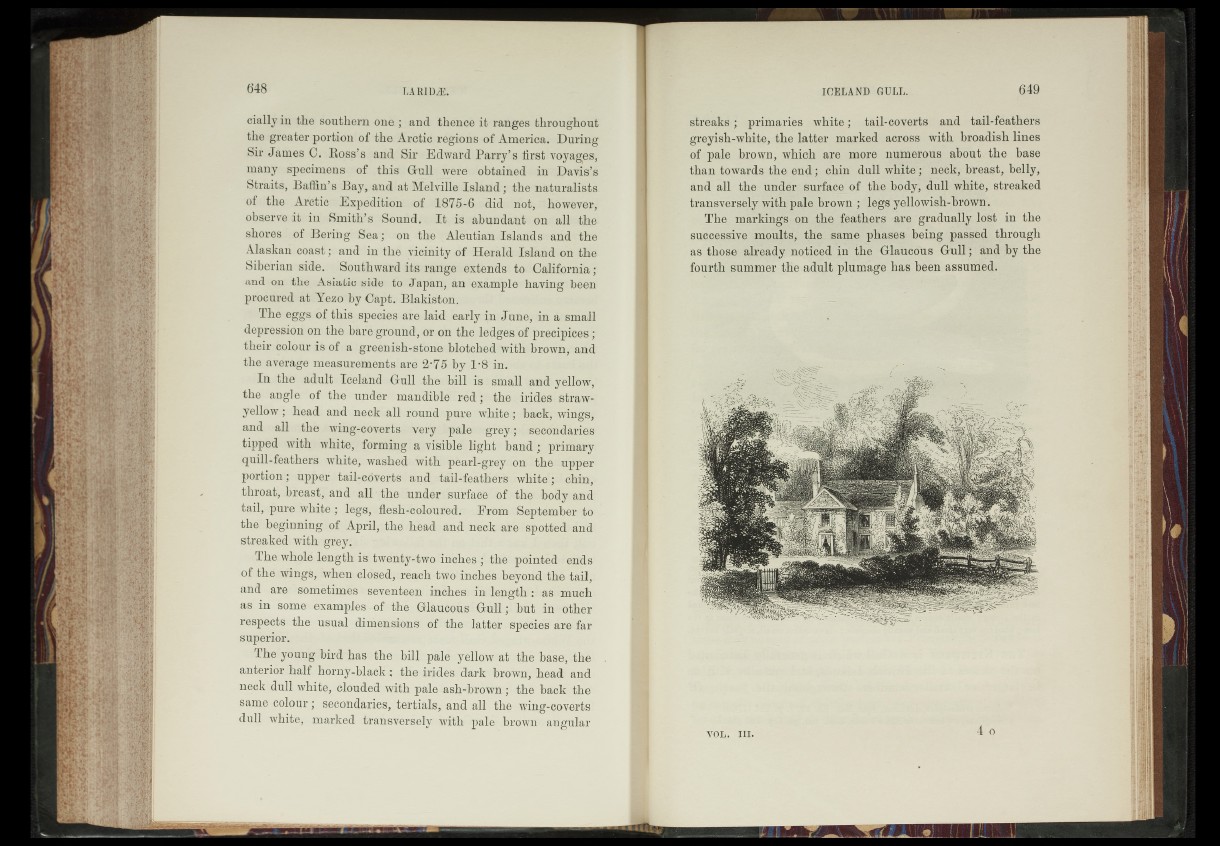
ciallyin the southern one; and thence it ranges throughout
the greater portion of the Arctic regions of America. During
Sir James C. Boss’s and Sir Edward Parry’s first voyages,
many specimens of this Gull were obtained in Davis’s
Straits, Baffin’s Bay, and at Melville Island; the naturalists,
of the Arctic Expedition .'of '1875*6 did not,rthowever,
observe -it. in Smith’s Sound* >. It is abundant on all the
shores of Bering Sea; on the Aleutian Islands and the
Alaskan coast; and h i the vicinity of'Herald' Island on the
Siberian side. Southward its range extends tod California;
and on the Asiatic side to Japan, an example having. been
procured at Yezoby Capt. Blakiston.
The eggs óf this species are laid ealsiLyi in »June, in a small
depression on the bare ground, or on thedeEges-hf precipices-;
their colour is of a greenish-stone-blotched-with brown, and
the average measurements are 2*75 by 1*8 in.
In jthe adult Iceland t*GE31 .the bill is small and yellow,
the angle'"of' the under mandible :red ; the irfdesjj straw-
yellow ; head and neck, all roundr.pure whiter; back, wings;'
and all the wing-covertsu very $ pale ^iëy^kseeéMdaties-
tipped with white," forming a visible1 light band;; primary,
quill-feathers white, washed^ .withhipharlrgrey. on ithe upper
portion; upper tail-edverts and tail4featlle']^^wMée^ilchin,
throat, .breast/ and all tbfê undérssurfaës^of the body and
tail, pure white ; tegsr; - flesh-^colouredjg - Erom | September Vto
the beginning of -April,; the .head and neck are-spotted; and
streaked with^gfey.*
The whole length is twëntystwo inches ;tfcfee:-pointéd lends
of thé wings, when closed,;reach two-inches beyond’the tail,-
and are 'sometimes"seventeen inehesvfn length;:: as Much-
as. in some exampfgs:-©f the Glaucous * Gull;-but m other
respects the usual-jpmensions of the latter-species are far
superior.
The young, bird has the bill paledyeliow’at the base, *tke>
anterior half horny-Maefc; the irides.-Eark brown, head and
neck dull white, clouded with pale ash-brownthe back- the
same colour; ^secondaries, tertials, and all the wing-^overts t
dull white, marked transversely -with pale bmwmangular
streaks ; primaries white; tail-coverts and tail-feathers
greyish-white, the latter marked across with broadish lines
of pale brown, which are more numerous about the base
than towardsithe end; chin dufl|white;' neck, breast, belly,
and all the under surface of the body; dull white, streaked
transversely ^ ith pale brown; legs' yellowish-brown.
The markings- on the feathers are gradually lost in the
successive/jmoults, th'e_ same phases being passed through
as those already noticed in’'the G.laucous GulT; ’ and by the
fourth summer the adult plumage has been assumed.
VOL. III. 4 o